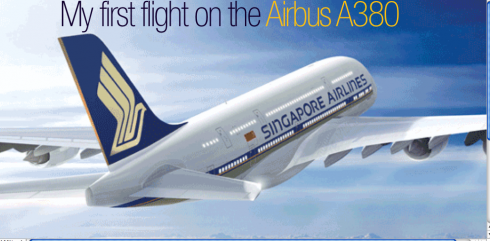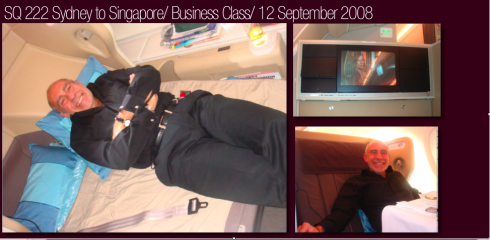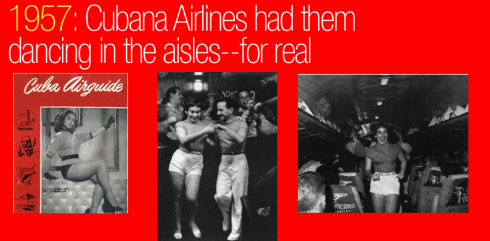

The flight: SQ 222, September 12, 2008
The route: Sydney to Singapore
The aircraft: A380
I had waited for this moment. After all, the Airbus A380 is as famous for its gigantic size and two full decks, up to 550 passengers, a crew of 21 on board as for its coverage in the business news pages as Airbus missed its delivery deadlines for the A380 repeatedly. In any case, Singapore Airlines was the first to have delivery of the super jumbo, and it uses it on its Singapore-Sydney-Singapore route.
On Friday, September 12, I took SQ 222 from Sydney to Singapore. I first saw the A380 from the gate, a big bubble marked by hundreds of little windows in two full decks. As I had a Business Class seat, I was told to follow one of those fingers that connect gate to aircraft that said Upper Deck. In other words, I never climbed any stairs, and, suddenly, there I was on the upper deck, taking my seat 17A.
Unquestionably, there is no bigger Business Class seat in the industry. I could have easily accommodated a companion sitting next to me, that is how wide that seat is. In front of me a console with a large screen, a mirror, outlets to connect computers or other gadgets, and around me spacious storage compartments, big enough to put a carry on bag, shoes, and whatever else one might carry as hand luggage. Not to mention that the overhead compartments could fit a suitcase or two.
Everything is big here
When it comes time to sleep, the flight attendant comes in and prepares the bed. A full bed, indeed, which could sleep two, for sure. I slept a few hours during the 8-hour Sydney to Singapore crossing.
The service: Singapore Airlines is legendary in the industry for its high level of service, which is why I was a little surprised that on this flight the aircraft was superior to the service on board.
Perhaps it was the location of my seat 17A, isolated and next to a galley. Perhaps the crew is still learning how to cope with so many passengers—-there are 60 business class seats on the upper deck.
But this was no traditional Singapore Airlines service at all: I had to call the flight attendant button three times to get bread with my appetizer, then again two times for another drink. True, the flight attendants—-those also famous Singapore Girls, as the airline refers to them—-were apologetic and jumped to action, but I have flown plenty of miles with Singapore Airlines, and never even knew where the flight attendant button was. Never had to use it.
Which goes to show that, at the end of the day, it is that human contact—-what they call service—-that counts, NOT so much the aircraft.
Transferring to Lufthansa
The flight: LH 779, September 12, 2008
The route: Singapore to Frankfurt
The aircraft: Boeing 747-400
Now I was on board the more familiar workhorse aircraft of long hauls worldwide, the robust Boeing 747-400, with its small upper deck bubble on top.
My business class seat here, 4D, is about half the width of that of the new Singapore Airlines A380. It does not lie flat and, well, it is unfair to compare here.
However, the Lufthansa service on this flight, this specific night, was spotless: systematic, well coordinated, and one never had to reach for the call button for anything.
I went to sleep for eight hours of the 12-hour flight, and, although I wished I had been on the wider, bigger SQ seat, I was happy to get the service that one is accustomed to on Lufthansa: precise and by the book. Yes, with smiles, and with the champagne flowing as desired.
At the end of the flight one remembers the service perhaps more than the aircraft.
<![]()
http://www.singaporeair.com/saa/en_UK/content/exp/A380/index.jsp
http://www.lufthansa.com/


The cabaret at 10000 feet: leave it to the Cubans
My flight on Singapore Airlines’ new Airbus 380 coincided with receiving an email from my Miami friend, Teresita Ros,who attached a glorious piece now making the rounds of the Internet among Cuban Americans.
Yes, it was Cubana Airlines that was doing top of the line marketing with its Tropicana Specials in 1957: taking part of the show from that world famous Havana nightclub to its flights from Miami to Havana.
Talk about Cuban ingenuity, this had to be the ultimate tool. Here is how it worked:
A stage was set up right on the cabin, and two of Tropicana’s best known dancers, Gloria and Roalndo, would perform all of their hot cha chas and mambos right on board during the one hour flight.
As the press release of the time announced: The fledgling nitery is Cubana Airlines’ Tropicana Special, an innovation in cabaret enterprise that has eliminated all the problems of drifting patrons.
No question about losing customers at 10000 feet. They stayed in their seats whether they liked the show or not.
The price sounds like fun, too. For a $68.70 ticket passengers would get the nightclub flight, an evening with dinner and drinks at the Tropicana itself, an over-night stay in a Havana hotel, breakfast, and return flight.
No extras for your suitcase, remember that! Airlines of today need to take note of the inventive Cubana Airlines of the 1950s.
The stage
Boarding the special, patrons find each of the 46 seats decked out in a specially designed seat-cloth bearing the special’s name and emblem. Up ahead, a gold curtain obscures the front of the cabin, which has been converted into a miniature stage, set off by a proscenium arch glowing with concealed lights.
Then as the cabin lights dim, Cruz gives a bilingual introduction to the show, welcoming the patrons aboard first in Spanish, then in English. Suddenly, the plane is filled with an infectious, rhythmic Latin tune.
Lap dancing at 10000 feet—a first?
No question that Cubana must have been the first and and only airline in the world to stage lap dancing. According to the press release of the time:
Some of the lucky males find their hair mussed, their cheek patted as she passes, and some return the favor. A few find her in their laps, smiling impishly and bounding out again before they regain their wits. One or two are invited to dance, and become part of the act on the tiny six-foot square stage, then return to their seats red-faced, flustered but immensely y pleased.
Women, too, are drawn into the act in this intimate revue as Rolando escorts them forward to dance.
Gloria varies the fares with a sweet-voiced rendition of ‘Siboney’ and the whole band joins in roaring ‘El Rancho Grande.’ The patrons follow the Spanish songs on little cards distributed for their use, occasionally are urged to join in a community song. Other numbers include a series of burlesque bits by a band member who mimics Maurice Chevalier with a battered straw hat and ‘Je Ne Sais Pas Why I Love You Like I Do.’
Sometimes it is the plane that does the mambo
Among the problems faced in launching the special was the primary one of converting the interior of a Lockheed Constellation to a nightclub atmosphere without losing too much payload.
‘We had to put in a stage without losing too many seats,’ explains Cruz. ‘We did it by taking out only eight two seats on each side of the aisle and combining that area with part of the service section just behind the pilot’s cabin.’
How about the piano?
The operators of Cubana had to take a baby upright and cut it down by one-fourth from 88 to 66 keys to make it fit. The piano is bolted to the plane floor to prevent injury to any of the performers or six-man special crew during rough weather.
And, how about turbulence?
The press release admits that sometimes it is the plane itself that does the mambo.
New York flight was next, but something happened on the way to the conga line
The possibility of a night club flight direct from New York was under consideration, but then Fidel Castro arrived, and he had a different idea, which did not include flights to Miami, and no dancing on the aisles.
Maybe the ailing airlines of the world need to take a retro look, get the piano and the guitar on board, and start the show.